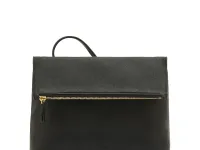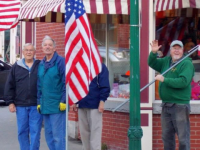Multi-film sets with Garland, Davis
Judy Garland Collection (1940-1954, Warner Archive Collection, 6 Blu-rays, 1 PG, 5 NR, 713 min.). Warner Bros. continues to issue value-priced, multifilm sets devoted to one actor. This six-film set of Judy Garland films is one, while the four-film Bette Davis set (see below) is another. Each film is reviewed separately.
Strike Up the Band (1940, NR, 120 min.). This was the second in a series of four musicals directed by Busby Berkeley that starred Judy Garland and Mickey Rooney. The first was “Babes in Arms.” The title song was written by the Gershwins and formed the basis of a 1927 musical theater production. In general, the film is likable, with the music numbers much better than the weak plot. One problem is that most of the musicians seem too old to be believable as high school students.
Rooney plays Jimmy Connors, a drummer in the Riverwood High School brass band who strongly wants a career as a dance band drummer, even though his mother is still set on him becoming a doctor like his late father. Jimmy comes up with the idea of forming a modern dance orchestra, instead of the stuffy brass band, and sells Principal Judd on the idea, if they can host a profitable dance. Jimmy is helped in his pitch by Mary Holden (Garland), whom he treats as a pal, although she would rather be his girlfriend. After the dance is a success, Jimmy has the idea of taking the band to Chicago to audition for the Paul Whiteman’s show that will feature a trio of high school bands. Whiteman and his orchestra appear in the film and perform a couple of numbers.
Musical highlights include the “Our Love Affair” duet at the piano by Rooney and Garland; the over-the-top music number to huge dance number of “La Conga”; and Garland singing “I Ain’t Got Nobody.” The closing number that includes “Strike Up the Band” is pure excess in the Berkeley style. Rooney, a drummer in real life, gets to do a couple of brief solos on the skins. One amusing animated bit has fruit performing as an orchestra in Jimmy’s imagination. There also is a fairly amusing production put on by Jimmy and Mary for the Elks club that makes fun of earlier, exaggerated stage shows.
A subplot features Larry Nunn (“Men of Boys Town”) as 13-year-old Willie Brewster, who has a big crush on Mary and often helps her out when Jimmy lets her down.
Extras include an introduction by Rooney (2007, 3:16); a stereo version of “Do the La Conga” (6:01); an Oct. 28, 1940 Lux Radio Theater broadcast of “Strike Up the Band” with Rooney and Garland (59:06, audio only); and a Rooney and Garland audio excerpt from the July 2, 1941 “Millions for Defense” radio show (15:15). Non-related bonus features are the cartoon “Romeo in Rhythm” (8:17); the Pete Smith specialty “Wedding Bills” (9:42); and “Leo in the Air” radio promo (14:15). Grade: film 3 stars; extras 2.75 stars
Girl Crazy aka Gershwin’s Girl Crazy (1943, NR, 98 min.). Busby Berkeley also staged the closing extravaganza of “I Got Rhythm” for this Micky Rooney-Judy Garland film, otherwise directed by Norman Taurog (“The Adventures of Tom Sawyer,” “Boys Town”). The film features 11 musical numbers by George Gershwin, each of which can be reached directly from the main menu, and several of which are performed by Tom Dorsey and His Orchestra.
Rooney plays Danny Churchill Jr., a publisher’s son with no real career goals. As the film opens, he and two women go to a club where Dorsey’s orchestra is performing and Churchill is forced to sing “Treat Me Rough.” It is a good, comic performance.
The next day, his father (Henry O’Neill of “The Story of Louis Pasteur”) sends him of to the male-only Cody College of Mines and Agriculture, out west. Churchill has to walk some 32 miles from the train station to the campus, but along the way he encounters Ginger Gray (Garland), the mail person, whose car has stopped working. Gray already knows of Churchill’s playboy reputation. Churchill, of course, is instantly infatuated, even though he learns Gray has a boyfriend in Henry Lathrop (Robert E. Strickland).
Ronney has plenty of comic scenes, including a ride on Whitey, a boisterous horse; and climbing all over Gray’s vehicle while singing “Could You Use Me?” to her. Another musical highlight is “Embraceable You,” performed by Garland during a student dinner-dance.
Plot-wise, the school will have to close down unless it gets at least 125 new students for the next year. Churchill comes up with the idea of a rodeo dance, including queen balloting. During the event, Dorsey’s orchestra does “Fascinatin’ Rhythm,” with Rooney on piano.
Extras include an introduction by Rooney (2007, 4:10); audio commentary by Graland biographer John Fricke; “I Got Rhythm” in stereo (7:31); the audio outtake “Bronco Busters” by Garland, Rooney and backing singers (2:22); “Hollywood Daredevils,” a Pete Smith specialty (9:21); and the Tex Avery cartoon “The Early Bird Dood It” (8:51). Grade: film 3.5 stars; extras 3 stars
Meet Me in St. Louis (1944, NR, 112 min.). The family-oriented film has songs by Hugh Martin and Ralph Blane, mostly based on feelings, and including highlights “The Trolley Song,” “The Boy Next Door” and “Have Yourself a Merry Little Christmas.” It is the story of a year in the life of the Smith family – 1903, starting seven months before the Louisiana Purchase Exposition, aka World’s Fair – and was directed by Vincente Minnelli, Garland’s future husband.
Garland plays Esther Smith, the second oldest daughter of three. She is attracted to their new neighbor, John Truett (Tom Drake of “Words and Music”). The eldest daughter is Rose Smith (Lucille Bremer of “Adventures of Casanova”), who is hoping her beau Warren Sheffield (Robert Sully of “Love Letters”), studying in New York City, will propose to her. The youngest girl is Tootie Smith (Maureen O’Brien of “The Secret Garden”).
The parents are played by Mary Astor (“The Maltese Falcon,” “The Philadelphia Story,” “Little Women”) and Leon Ames (“On Moonlight Bay”), with Harry Davenport (“Gone with the Wind,” “The Hunchback of Notre Dame”) as Grandpa. Marjorie Main (several “Ma and Pa Kettle” films) is Katie, the maid.
Also in the cast are June Lockhart (TV’s “Lost in Space”) as Lucille Ballard, Hugh Marlowe (“All About Eve,” “The Day the Earth Stood Still”) as Col. Darly and Chill Wills (“Giant,” “McLintock!”) as Mr. Neely.
The film comes with audio commentary by John Fricke, O’Brien, Irving Brecher, Martin and Barbara Freed-Saltzman; an introduction by Garland’s daughter Liza Minnelli (4:59); a making-of narrated by Roddy McDowell (30:47); the 1966 TV pilot starring Shelley Fabares and Celeste Holm (26:35); “Hollywood the Dream Factory” (50:31); “Bubbles” (7:54), with Garland’s earliest film performance; “Skip to My Lou” by the Martins (3:11); the Dec. 2, 1946 Lux Radio Theater version with Garland, O’Brien and Drake (57:12); audio outtake “Boys and Girls Like You and Me” (3:37); and a music only track for the film. Grade: film 3.25 stars; extras 3.5 stars
In the Good Old Summertime (1949, NR, 102 min.). This is a remake of 1940’s “The Shop Around the Corner,” only moved to a music store in Chicago and with seven songs added. The story remains the same of two newly co-workers being each other’s secret pen pals. They are Van Johnson (“The Caine Mutiny,” “Thirty Seconds Over Tokyo”), who narrates and plays Andrew Larkin, the top salesman at the store, and new hire Veronica Fisher (Judy Garland).
It is basically an enemies-to-lovers story, with Larkin learning midway through the film that Fisher is his correspondent and she not learning who he is until the final minute.
The store is owned by Otto Oberkugen (S.Z. Sakall of “Casablanca,” “Christmas in Connecticut”), who is wooing employee Nellie Burke (Spring Byington of “You Can’t Take It with You,” “Heaven Can Wait”). Oberkugen has bought 100 small harps, which Larkin insists was a mistake. Fisher sells the only one, winning her a job. Oberkugen’s nephew Hickey is played by Buster Keaton (“The General,” “The Navigator”). Larkin has a violinist friend in Louise Parkson (Marcia Van Dyke).
Extras include an introduction by John Fricke (2004, 4:20); and two James A. FitzPatrick travelogues on Chicago, “Chicago the Beautiful” (10:15) and “Night Life in Chicago” (8:53), which ignores the city’s vibrant blues scene. Grade: film 3 stars; extras 2 stars
A Star Is Born (1954, PG, 176 min.). Directed by George Cukor ("My Fair Lady," "The Philadelphia Story"), the film stars Judy Garland and James Mason as Vicki Lester and Norman Maine. Tony Award-winning playwright Moss Hart wrote the screenplay, based on the 1937 film. This versionh received only six Oscar nominations -- one less -- including for Garland, Mason, art direction-set decoration, costume design, musical scoring and original song for "The Man That Got Away" by Harold Arlen and Ira Gershwin, but did not win any Oscars. Mason and Garland did win Golden Globes. This is my favorite of the four major film versions. This version was famously reconstructed in the early 1980s under the leadership of late film historian Ronald Haver.
The story is about the doomed marriage of an entertainer whose career is on the rise (Lester) and her husband whose career is in decline (Maine). The film marked Garland's return to movies after a four-year absence, director Cukor's first musical and first color film, and a showcase for great Harold Arden and Ira Gershwin songs. One of the most beloved show business stories of all time, the film represents a career peak for many involved. The film’s impressive supporting cast includes Jack Carson, Charles Bickford and a host of Hollywood luminaries. Songs include "The Man That Got Away," "Lose That Long Face" and Garland’s tour de force performance of "Born in a Trunk."
This edition has no extras. Grade: film 5 stars
Rating guide: 5 stars = classic; 4 stars = excellent; 3 stars = good; 2 stars = fair; dog = skip it
Bette Davis Collection (1938-1940, Warner Archive Collection, 4 Blu-rays, NR, 409 min.). The set contains four of Davis’ best Warner Bros. films. They are individually reviewed.
Jezebel (1938, NR, 104 min.). This Southern Gothic film, which won Bette Davis the second of her Academy Awards (she was nominated for eight Oscars between 1935 and 1945, winning twice), came between the publication of the book and the making of the film “Gone with the Wind” and thus did very well at the box-office. It was directed by William Wyler, future Best Director Oscar winner for “Ben Hur,” and written by Clements Ripley, Abem Finkel and John Huston (“Moby Dick,” “The Maltese Falcon,” “High Sierra” etc.), based on Owen Davis Sr.’s play. The play only lasted 30 performances on Broadway and ironically starred Davis’ rival, Miriam Hopkins.
Davis Plays New Orleans belle Julie Marsden. The film opens in 1852, when society rules were still in place, but Marsden likes to flaunt them. Her beau, for at least the second time, is Pres Dillard (Henry Fonda in an early film), a banker. Amusingly, one of the rules she flaunts is storming into the bank after Dillard one time – apparently women never went into banks in those days.
Marsden has been using Buck Cantrell (George Brent of “The Rains Came,” “Dark Victory” with Davis) to make Dillard jealous and/or bow to her will; however, Cantrell is prone to participate in duels, including one later with Dillard’s younger brother (Richard Cromwell of “Baby Face Morgan” as Ted Dillard). The final straw for Dillard – and a devastating scene – is when Marsden refuses to wear a white dress, as all the unmarried women do, to the Olympus Ball. She instead wears an outrageous red dress and they are scorned by the other couples. Thus, the dress actually ends their relationship. Their resulting quarrel leads to Dillard being gone a full year, and when he returns, it is with a wife (Margaret Lindsey as Amy). Meanwhile, there has been an outbreak of Yellow Fever and Marsden and her set have retreated to her Halcyon plantation.
Davis is excellent in her often-fiery lead role. The clinging to societal rules will seem strange to young viewers, who also may find troublesome the treatment of African-American slaves as just happy go-lucky employees. There is a dinner discussion about abolitionists, with Dillard carrying a more modern outlook, while Cantrell is old-school.
Fay Bainter, who plays Aunt Belle Massey, won the Best Supporting Actress Oscar. She also was nominated that year for leading actress for her role in “White Banners” and would later be nominated again as supporting actress for “The Children’s Hour” in 1962. “Jezebel” also received Oscar nominations for Best Picture, Best Cinematography (Ernest Haller, who would be nominated a total of seven times and win the next year for “Gone with the Wind”) and Best Music Score (Max Steiner, 24 Oscar nominations overall, with three wins).
Extras include a 2006 featurette on the making of the film, “Jezebel: Legend of the South,” which is well done; audio commentary by film historian Jeannine Basinger, also from the 2006 DVD release; the vintage musical short, “Melody Masters: Jimmy Dorsey and His Orchestra”; “Daffy Duck in Hollywood” cartoon; and the promotional “Rambling ‘Round the Hollywood Studio with the Candid Cameraman.” The featurette points out Wyler’s fondest for long tracking shots, such as the one down a New Orleans street that shows all the workers and sellers along the street. Grade: film 3.25 stars; extras 2.75 stars
Dark Victory (1939, NR, 104 min.). The year after Bette Davis won her second Academy Award for her work in “Jezebel,” Davis again was at the top of her craft in “Dark Victory,” playing heiress Judith Traherne, only 23 but dying of a brain disease. She was again nominated for an Oscar, but 1939 was the year of “Gone with the Wind.” “Dark Victory” also received Oscar nominations as Best Picture and for Max Steiner’s score.
Traherne owns horses, including one she believes will be a steeplechase champion. Somewhat amusingly, knowing what he will accomplish later, her Irish horse trainer, Michael O’Leary, is played by Humphrey Bogart (“Casablanca,” “The Maltese Falcon”). Even less seen is future president Ronald Reagan as playboy Alec.
The male lead is Traherne’s new doctor, neurosurgeon Frederick Steele (George Brent of “Jezebel”), who was about to move to Vermont and do cell research, before she became his patient just before his train was about to leave. He stays and they fall in love, but he withholds the prognosis that her brain surgery will not prevent her dying in 10 months. He says she will be able to act normal until blindness comes near the end.
Get out your handkerchiefs. Extras include audio commentary by film historian James Urisini and CNN film critic Paul Clinton; a discussion of 1939’s bevy of exceptional films (9:33); audio of the Jan. 8, 1940 Lux Radio Theater version of “Dark Victory,” starring Davis and Spencer Tracy (59:12); a newsreel (2:04); the “Robinhood Makes Good” cartoon (7:47); and a short film on Andrew Jackson in 1812 (16:50). Grade: film 3.75 stars; extras 2.5 stars
The Private Lives of Elizabeth and Essex (1939, NR, 106 min.). The film, directed by Michael Curtiz (“The Adventures of Robin Hood,” “Casablanca”), whom Bette Davis reportedly did not like working with, definitely shows its Maxwell Anderson-penned stage play origins, but Curtiz at least works in a couple of sequences of the British army moving into combat. Davis plays Queen Elizabeth I, who is very much in love with an ambitious younger man, Robert Devereux, the Earl of Essex (Errol Flynn, who had made “The Adventures of Robin Hood” and “Captain Blood” with Curtiz previously). However, theirs is a love-hate relationship, with military man Devereux wanted to rule with Elizabeth, and Elizabeth wary of his ambition.
While Devereux returns in triumph to London after defeating the Spanish, Elizabeth chides him for allowing the Spanish to destroy their fleet, as she had wanted those ships for her navy. With the Irish rebelling under the Earl of Tyrone (Alan Hale of “The Adventures of Robin Hood,” “The Sea Hawk,” also starring Flynn and directed by Curtiz), Elizabeth at first refuses to allow Devereux to go off and fight them, preferring to have her lover nearby. However, sulking Devereux has retired to his country estate.
Look for Vincent Price (many a horror film) as Sir Walter Raleigh, Leo G. Carroll (Alfred Hitchcock’s “North by Northwest” and “Strangers on a Train,” TV’s “The Man from U.N.C.L.E.”) as Sir Edward Coke and a young Nanette Fabray (“The Band Wagon,” TV’s “One Day at a Time”) as Margaret Radcliffe. Olivia de Havilland (“The Adventures of Robin Hood”) plays the duplicitous Lady Penelope Gray, who destroys correspondence between Elizabeth and Essex as she loved Essex in vain. Francis Bacon, the Queen’s advisor, is played by Donald Crisp (“How Green Was My Valley”).
Davis, who had her eyebrows and hairline shaved and her face painted chalky white for the part, would get revenge on de Havilland 25 years later in “Hush … Hush Sweet Charlotte” (1964).
The film was nominated for five Oscars, including Best Cinematography (Sol Polito, W. Howard Greene), Best Art Direction (Anton Grot), Best Sound Recording (Nathan Levinson), Best Effects or Special Effects (Byron Haskin, photographic, Nathan Levinson, sound) and Best Music Scoring (the great Erich Wolfgang Korngold). Korngold won his Oscar for “The Adventures of Robin Hood” and would receive another nomination for “The Sea Hawk” in 1940.
Leonard Maltin introduces “Warner Night at the Movies 1939,” which includes a newsreel about Denmark versus the Nazis, an “Old Glory” cartoon with Porky Pig and “The Royal Rodeo” musical short (14:25) starring John Payne. There also is the featurette “Elizabeth and Essex: Battle Royale” (10:35), in which it is stated that Davis detested Flynn and had wanted Laurence Olivier for the part. Grade: film 3 stars; extras 2.75 stars
The Letter (1940, NR, 95 min.). Two years later, star Bette Davis, director William Wyler and composer Max Steiner reassembled to make “The Letter,” in which Davis plays Leslie Crosbie, who must be saved from a murder charge. The setting for this second of three collaborations between Davis and Wyler – the third was to be “The Little Foxes” the next year – is a Singapore rubber plantation. The screenplay is by Howard Koch, based on a play by W. Somerset Maugham, who also wrote “Of Human Bondage,” the film of which made Davis a star six years earlier.
Leslie is clearly guilty; the question is whether it was self-defense. Wyler’s opening long tracking shot moves through the plantation house’s front yard, where workers are sleeping. Then a gunshot disturbs the night, followed by a second and then a burst of four more. We see Leslie shoot and kill Geoffrey Hammond, with the last four shots going into his back after he already is on the ground. She then sends servants to gather her lawyer (James Stephenson as Howard Joyce) and a police investigator (Bruce Lester as John Withers). Robert Crosbie (Herbert Marshall of “Foreign Correspondent,” “The Fly”), Leslie’s husband, also is summoned from his work station.
Leslie claims Hammond made unwanted sexual advances towards her and she shot him to avoid being overpowered. However, three days later, Joyce’s assistant (Victor Sen Yung as Ong Chi Seng) comes up with a copy of a letter that purportedly was an invitation by Leslie for Hammond to visit her the day of the killing, as her husband would be away. In the letter, she even tells Hammond to park down the road. Joyce’s dilemma is that in order to save his client, he must break the law and obtain the letter, paying a $10,000 ransom.
It is another strong performance by Davis, who earned one of the film’s seven Oscar nominations. However, the treatment of Hammond’s Eurasian wife (Gale Sondergaard as Mrs. Hammond) is racially biased. What also sticks out is that Leslie’s jury of her peers is made up of only men. The story turns very melodramatic after the trial. The film’s other Oscar nominations were for Best Picture, Best Actor in a Supporting Role (Stephenson), Best Director (Wyler), Best Cinematography (Tony Gaudio), Best Film Editing (Warren Low) and Best Original Score (Steiner). The Oscar, however, eluded all the nominees.
Bonus features include an alternate ending that differs only slightly (9:59) and two Lux Radio Theater audio adaptations of the play: an April 21, 1941 one with Davis, Stephenson and Marshall; and a March 6, 1944 one with Davis and Marshall. Grade: film 3 stars; extras 2.25 stars
Peanuts: Ultimate TV Specials Collection (1965-2011, Warner Bros., 5 Blu-rays or 5 DVDs, NR, 1.085 min.). Since Charles Schulz first introduced the kid with the zigzag shirt, fans of all ages have loved the Peanuts gang. This 75th-anniversary compilation features 40 TV specials that celebrate the charm and humor that have established Charlie Brown, Lucy, Linus, Snoopy and their friends as cultural treasures. The set includes most beloved specials and potential new favorites in the comprehensive collection.
The set includes holidays, including Christmas, Thanksgiving, Easter, Valentine’s Day and Arbor Day. In all, a most delightful collection. Grade: set 4 stars
Supernova (2020, Wolfe, Blu-ray, R, 95 min.). Sam (Colin Firth of “Mamma Mia!,” “The King’s Speech,” the “Bridget Jones” films) and Tusker (Stanley Tucci of “Spotlight,” “The Lovely Bones,” “The King’s Man”) have been a couple for 20 years. Now, they are touring around England in their old campervan, visiting places special to them and relatives and friends. Sam is a recorded pianist, who has slated one final concert. Tusker is a writer, but has been diagnosed with dementia two years earlier. Their time together is the most precious thing for both.
Both men give excellent, believable performances. Tusker is nearing the final stage of dementia, losing many of his abilities to remember people and things. He knows he will not recognize his husband’s face or name. Sam will still have the memories, but the man he knew and loved will be gone in a sense. However, they will never stop loving each other.
The film, written and directed by Harry Macqueen, is at its best when the two men communicate through a look or a touch. A highlight comes at a dinner with Sam’s family and friends. Tusker is supposed to read a speech at the dinner, but he cannot because of his condition, and so Sam reads the words his lover has written, many of them about him.
The only extra is a featurette (2:03). Grade: film 3.5 stars
1985 (2018, Wolfe, Blu-ray, NR, 85 min.). Directed and co-written by Yen Tan (with Hutch Crane), this is another at-times emotionally difficult film to watch, as the main character, although relatively young, returns home to Texas after three years for probably his last Christmas with his parents and preteen brother.
The film is centered by Cory Michael Smith (“Saturday Night,” TV’s “Transatlantic”) as the melancholic Adrian Lester, a closeted gay man who has been living in New York City the past three years and whose lover Leo died nine months after his AIDS diagnosis. His very religious parents are well played by Virginia Madsen (“Sideways,” “Candyman”) and Michael Chiklis (“Fantastic Four: Rise of the Silver Surfer,” TV’s “The Commish”).
Adrian’s young brother Andrew (Aiden Langford of TV’s “Bosch”) has his father worried about him, as he has given up football and now is vice president of the school’s drama club. He also listens to tapes of Madonna and other secular music his father dislikes and often throws away. Adrian obviously accepts the “new” Andrew and encourages him to be his true self.
Adrian also reconnects with his old high school girlfriend Carly (Jamie Chung of TV’s “Gotham,” “The Gifted”), now trying to be a stand-up comedian. A fun evening turns bad when Adrian spurns her sexual come-ons. She later visits him and he shares the truth of who he is and his likely future.
The only extra is the original short film (8:59). Grade: film 3.5 stars
Paris 05:59: Théo & Hugo (France, 2016, Wolfe, Blu-ray, NR, 101 min.). Théo (Geoffrey Couët) and Hugo (François Nambot) meet at The Impact, a sex club. Both are twentysomething and in good shape. Théo is attracted to Hugo, so much that everybody else fades into the shadows. The film has a very adult first 20 minutes.
After this initial, carnal meeting, the two go upstairs, get their clothes and leave together, taking rented bicycles through the city. When they realize that Théo did not used a condom, and since Hugo is HIV positive, they panic, calling a hotline that leads to an emergency room visit.
Hugo is in treatment and has a negligible viral load, so the chances of Théo becoming infected are low. Starting an immediate course of treatment can reduce his risk still further. They support each other through the hospital visit and then continue on, learning a little about each another's lives along the way. By the time of the title, they are determining whether there is room for the unexpected something that might be happening between them.
It is another well-acted film, directed and written with sensitivity by Olivier Ducastel and Jacques Martineau (“The Adventures of Felix”). The only extra is a short film in which two men, partners of 22 years, recall their initial encounter in an adult book store’s back room (3:51). Grade: film 3.25 stars
About this blog:

My music review column, Playback, first ran in February 1972 in The Herald newspapers of Paddock Publications in Arlington Heights, IL. It moved to The Camden Herald in 1977 and to The Courier Gazette in 1978, where it was joined by my home video reviews in 1993. The columns ran on VillageSoup for awhile, but now have this new home. I worked at the Courier Gazette for 29 years, half that time as Sports Editor. Recently, I was a selectman in Owls Head for nine years.



























